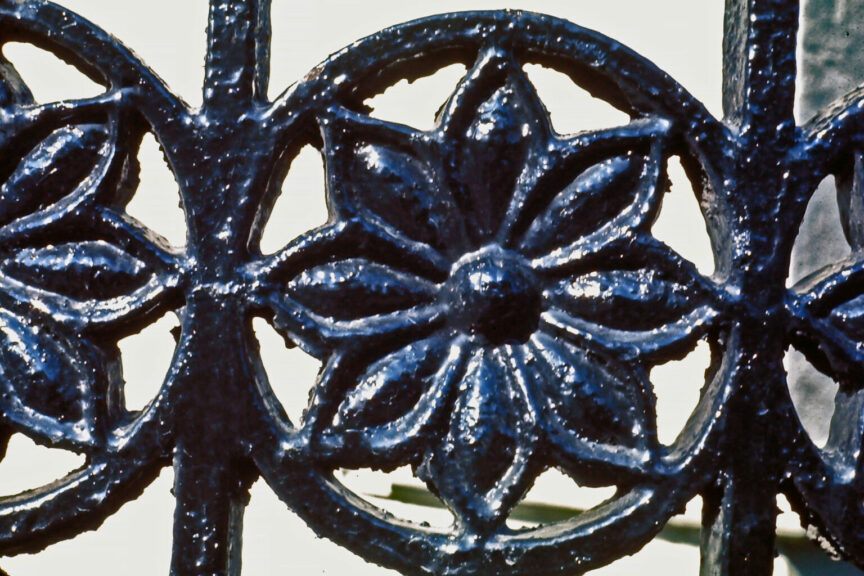In the 1970s I kept returning to the intersection of Barrington and Spring Garden to take pictures of the three iron fences that line the corner where two of our historic commercial streets meet.
My favourite of the fences, in front of St. Matthews, has a row of flowers that could easily be converted to golden Ukrainian sunflowers surrounded by a blue circle.

Photo 1974
The granite posts at the entrance to the side yard of the Church survive today but this Gothic style gate is long gone (it could be replaced). If you don’t recognize the background view that’s because it is now blocked by the Maritime Centre. Hello, random view of Dartmouth.

That’s the Nova Scotia Hospital across the the harbour. At this time if you said “buddy’s in Dartmouth” everyone knew what you meant. Photo c1975
The front doors of the church have theatrical cast iron hinges.

Photo c1975
When the door was open you could see who actually did all the heavy hinge work.

Photo 1977
Viewed in winter light, I vote St. Matthew’s the prettiest church in Halifax. Over the decades a lot of effort has gone into maintaining the building, and that is an endless job. Churches understand the concept of eternity.

Photo 1978
The fence around the Old Burying Ground flows down Spring Garden and then curves onto Barrington. It was an important element in the redevelopment of this area in 1860 when St. Matthew’s, the Court House and the Crimean War Memorial were all new. The fence once continued in front of the Court House, visually stitching the block together.

Photo c1980
Imagine my dismay in the spring of 1983 when I happened to be walking along Spring Garden Road and saw that section of this fence had collapsed. Cast iron is very brittle and heavy; the posts cleanly snapped at their base. I don’t know what started the chain reaction, did it jump or was it pushed?

Photo 1984
My first thought was this fence is toast and will be replaced by chain link; but somehow it was resurrected and has lived on for another 40 years. See what you can do, Halifax, if you try?

Photo 1984
On the northwest corner of the intersection is the 1891 St. Mary’s Glebe House and its iron fence, 30 years younger than the St. Matthew’s and Burying Ground fences.

Photo 1976
Not surprisingly the fence design is quite different from what we’ve just been seeing. I wonder if the Irish Catholics of St. Mary’s saw those little leaf forms as trefoils or shamrocks? Personally I’m going with trefoils.

Photo 1974
The points on the top rail are a classic element of hostile design, there is no sitting on this fence.

Photo c1974
The Glebe fence is another success story. About 1995 the fence was extended up Spring Garden to surround the church’s paved-over cemetery. This might have happened with funding allocated to clean up the downtown for the G7 meeting. Whatever it takes.
Of course I’ve been avoiding the herd of elephants in the room, the monster Maritime Centre that was “completed” in 1977. The bitter wind tunnel this structure created at the pedestrian level is a good enough explanation for why the downtown failed. Not enough people cared.

Photo 1977
In this 1978 view, the spire of St. Matthew’s still rises above the fourteen-story Maritime Centre. Now not so much because another seven stories were added in 1988.

Photo 1978
Postscript
- One of my 1974 photos of the Glebe House fence happens to capture the tiniest sliver of the Capital Theatre on Barrington Street. This urban fantasyland was about to be demolished by Maritime Tel and Tel to make way for the Maritime Centre. I seem to have been too interested in my cast iron to actually take a photo of the Capital. A thesis by a St. Mary’s anthropology student suggests that so much was happening in the heritage community at that moment there was not enough bandwidth to mount a campaign with any hope of saving this very particular theatre. Thanks telephone company, for your service and imagination.

Photo 1974
It is easy to find the story and pictures of the Capital online. In the auditorium there were eight giant murals depicting what folks in 1930 thought were significant moments in Nova Scotian history. A couple of them are easy to see today. A dramatic landing at one of the sieges of Louisbourg hangs high in the concourse at Historic Properties. People like to imagine that stone salvaged from Louisbourg was used in some of the early Halifax buildings, like Historic Properties.

Photo 2018
The founding of Halifax mural is conveniently located next to public washrooms on the ground floor of the Public Archives.

Photo 2017
- While I was poking around this corner I came upon Adam, Eve, and that pesky snake, a masterpiece of eighteenth century art, set into the asphalt of the St. Mary’s Basilica parking lot. This was once the Catholic cemetery, and the sculpture was the end panel from a tomb carved by the Hay family of Halifax. Deb Trask (the gravestone queen and my colleague at the Museum) arranged to have St. Mary’s University archaeology students excavate the panel that is now in the NS Museum collection.

Photo 1977






